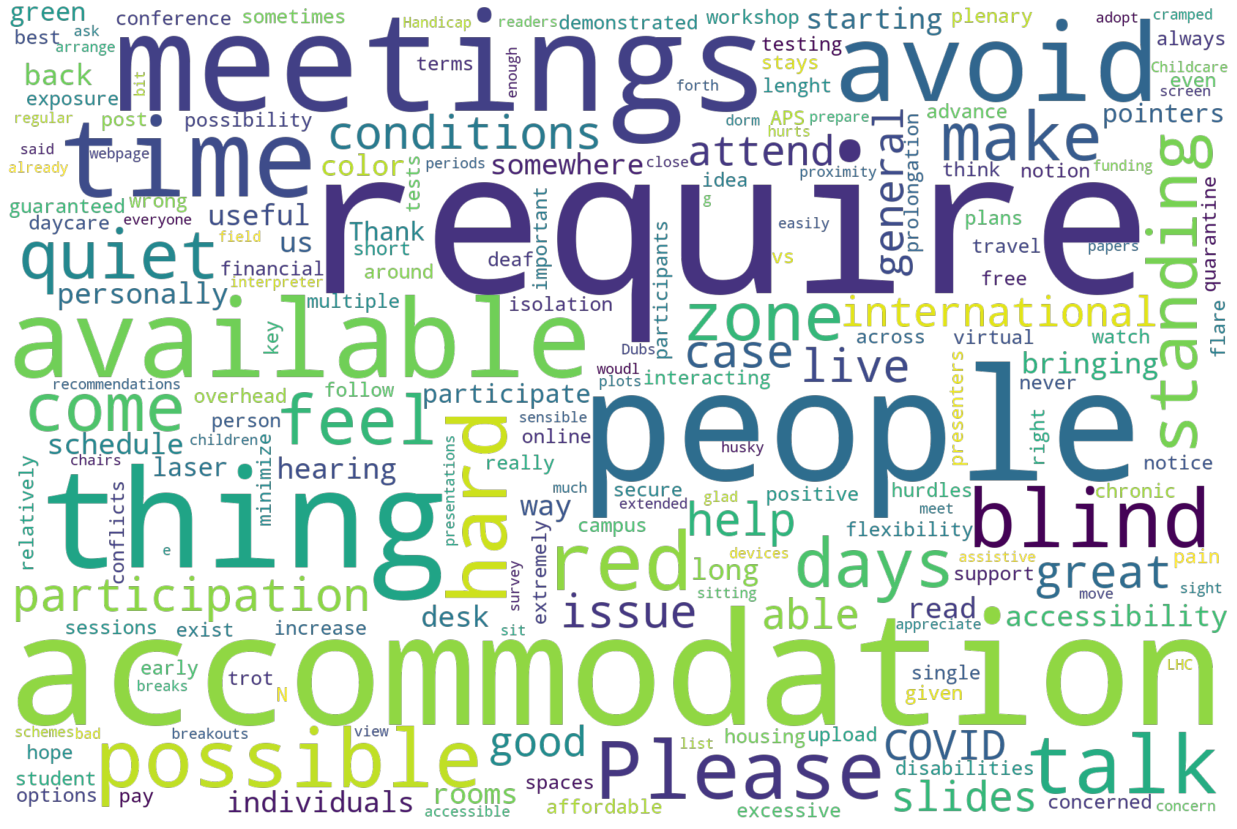Acommodations
Contents
Acommodations¶
Responses here do not lend themselves easily to plots for two reasons. First, most people do not need accomodations, but for those that do need it, they have very specific requirements.
from config import survey, plot_wordcloud, make_wordcloud, build_attend
import altair as alt
First, when asked how much of an issue accomodation might be in preventing attendance, the response was very low. The numbers in these plots can be interpreted as:
1 - Likely will prevent me from attending
2 - Might prevent me from attending
3 - Could attend, but might limit participation
4 - Not a concern
5 - Unknown
brush = alt.selection_single(encodings=['y'])
attend = build_attend(selection=brush)
charts = [
{
'name': "COVID",
'col': "worried_covid"
},
{
'name': "Funding",
'col': "worried_funding"
},
{
'name': "Length",
'col': "worried_length"
},
{
'name': "Accessability",
'col': "worried_accessibility"
},
{
'name': "Responsibilities",
'col': "worried_responsibilities"
},
]
c_list = [
(alt.Chart(data=survey, title=c_info['name'])
.transform_filter(brush)
.mark_bar()
.encode(
x=alt.X(shorthand=f"{c_info['col']}:N", title="", axis=alt.Axis()),
y=alt.Y(shorthand="count()",title="Number of people", scale=alt.Scale(domain=(0, 650))),
tooltip=alt.Tooltip("count():N"),
)
)
for c_info in charts
]
c = None
for p in c_list:
if c is None:
c = p
else:
c = c | p
attend & c
Hearing¶
Unfortunately it was not possible to analyze the data easily, and directly. Google can accomodate commas in the text, but also between anwers - so it was impossible to tell the difference between the two types of answers. As a result we had to analyze this by hand.
14% of respondents indicated that at least one of the hearing-related accommodations would be helpful.
2% indicated that live captioning or ASL interpretation would be necessary for their full participation.
1% said an assistive listening device or amplification service would be helpful.
Other accomodations¶
23% of respondents indicated that another accommodation would increase accessibility of Snowmass for them:
16%: A “Quiet Zone” near the meeting rooms where people can go to rest without interaction
9%: Seating available at all events, breaks, meals, discussion areas
3%: Assistance in traveling around campus
4%: Use of colorblindness-friendly color schemes in presentations
1%: Alt-text describing images in presentations
1%: Specific furniture
Comments¶
We also had a freeform entry for comments. Of the 728 people that filled in the survey:
print("Number of freeform entry comments left in survey: " + str(len(tuple(s for s in survey['acc_comments'] if isinstance(s, str)))))
Number of freeform entry comments left in survey: 30
plot_wordcloud(make_wordcloud(survey['acc_comments'], ['meeting', 'need']))

People suggested many other types of accommodations:
Provide time and space for spur-of-the-moment discussions between attendees
Plan frequent and long-enough breaks
Have people upload talks ahead of time
Provide guidance on how to use colorblindness-friendly color schemes
Require green laser pointers
Plan breaks that are long and frequent enough
Ensure mobility-related accessibility of buildings and accommodations
Hold all events close to each other and to accommodations
Have good chairs as well as some tables and standing desks in meeting rooms
Provide private space for medical procedures and breastfeeding
Spell out acronyms
Accommodate dietary restrictions
Provide masks
Provide a remote or hybrid attendance option
Make plenaries available online
Avoid weekends
Make it possible to participate for partial meeting
Provide childcare assistance (financial and logistical)
Provide financial assistance with conference costs
Provide refunds if covid prevents travel
Support participants required to isolate because of covid
Provide private space to attend non-Snowmass meetings